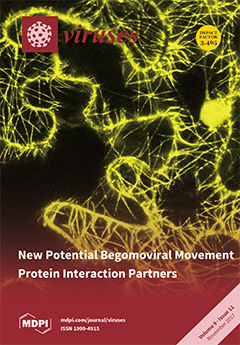Geminiviral single-stranded circular DNA genomes replicate in nuclei so that the progeny DNA has to cross both the nuclear envelope and the plasmodesmata for systemic spread within plant tissues. For intra- and intercellular transport, two proteins are required: a nuclear shuttle protein (NSP) and a movement protein (MP). New characteristics of ectopically produced Abutilon mosaic virus (AbMV) MP (MP
AbMV), either authentically expressed or fused to a yellow fluorescent protein or epitope tags, respectively, were determined by localization studies in mammalian cell lines in comparison to plant cells. Wild-type MP
AbMV and the distinct MP
AbMV: reporter protein fusions appeared as curled threads throughout mammalian cells. Co-staining with cytoskeleton markers for actin, intermediate filaments, or microtubules identified these threads as re-organized microtubules. These were, however, not stabilized by the viral MP, as demonstrated by nocodazole treatment. The MP of a related bipartite New World begomovirus, Cleome leaf crumple virus (ClLCrV), resulted in the same intensified microtubule bundling, whereas that of a nanovirus did not. The C-terminal section of MP
AbMV, i.e., the protein’s oligomerization domain, was dispensable for the effect. However, MP expression in plant cells did not affect the microtubules network. Since plant epidermal cells are quiescent whilst mammalian cells are proliferating, the replication-associated protein Rep
AbMV protein was then co-expressed with MP
AbMV to induce cell progression into S-phase, thereby inducing distinct microtubule bundling without MP recruitment to the newly formed threads. Co-immunoprecipitation of MP
AbMV in the presence of Rep
AbMV, followed by mass spectrometry identified potential novel MP
AbMV-host interaction partners: the peptidyl-prolyl cis-trans isomerase NIMA-interacting 4 (Pin4) and stomatal cytokinesis defective 2 (SCD2) proteins. Possible roles of these putative interaction partners in the begomoviral life cycle and cytoskeletal association modes are discussed.
Full article






